An emergency evacuation plan is a crucial aspect of home safety. It is a blueprint that outlines the steps that should be taken in case of an emergency, such as a fire, natural disaster, or other crisis. Having a plan in place can help ensure that everyone in your household knows what to do and where to go in the event of an emergency, reducing the risk of injury or death.

This article will provide a step-by-step guide on how to create an emergency evacuation plan for your home. It will cover identifying potential hazards, developing the plan, practicing and testing the plan, and conclude with additional resources for further information on emergency preparedness.
1.Common hazards that can lead to the need for evacuation
There are many different hazards that can lead to the need for evacuation, including fires, natural disasters, and even chemical spills or gas leaks. It’s important to understand the specific hazards that are most likely to occur in your area so that you can tailor your emergency evacuation plan accordingly.
2.Steps for identifying specific hazards
- Research the types of natural disasters that are most likely to occur in your area (e.g. hurricanes, tornadoes, earthquakes, floods)
- Identify any potential fire hazards in your home (e.g. smoking, faulty wiring, flammable materials)
- Check for any gas or water leaks that could cause a problem.
- Look into the risk of chemical spills in your local area and the proximity of any chemical plants or factories.
- Consult with local emergency management agencies to get an understanding of the types of hazards that are most likely to occur in your area.
- Assess the accessibility of your home and surrounding areas for individuals with mobility challenges.
By identifying these hazards, you can take steps to mitigate the risk and create a plan that is specific to your home and needs.
3.key elements of an emergency evacuation plan:
An emergency evacuation plan should include the following key elements:
- Emergency meeting point: A designated location outside the house where everyone should meet after evacuating.
- Escape routes: Two or more ways to exit each room of the house.
- Communication plan: A way for everyone in the household to communicate with each other during an emergency.
- Emergency contact list: A list of emergency contacts, including phone numbers of family members, friends, and emergency services.
- Emergency supply kit: A kit that includes essentials such as first aid supplies, water, non-perishable food, and a flashlight.
4.Tips for creating a plan that is specific to your home and needs
- Make sure everyone in the household is familiar with the plan, including children and older adults.
- Involve everyone in the household in the process of creating the plan.
- Customize the plan based on the specific hazards in your area and your household’s needs.
- Review and update the plan regularly.
- Have a plan for individuals with mobility challenges.
5. How to involve all members of the household in creating the plan
- Involve everyone in the planning process, including children and older adults.
- Assign specific roles and responsibilities for each member of the household.
- Ask for input and suggestions from everyone in the household.
- Make sure everyone understands the plan and their role in it.
- Practice the plan regularly with everyone in the household.
By developing a plan that is specific to your home and needs, you can increase the chances of a successful evacuation in the event of an emergency.
6. Importance of practicing the evacuation plan regularly:
Practicing the evacuation plan regularly is crucial to ensure that everyone in the household knows what to do and where to go in case of an emergency. It helps identify any weaknesses in the plan and allows for adjustments to be made before an actual emergency occurs.
7. Tips for testing the plan and making any necessary adjustments
- Conduct fire drills and evacuation drills regularly to test the plan.
- Use different scenarios (e.g. night-time evacuation, evacuation during a power outage) to test the plan.
- Involve local emergency services to test the plan and provide feedback.
- Review and update the plan regularly to reflect any changes in the household or the surrounding area.
- Make sure that everyone in the household is familiar with the plan and their role in it.
8. How to involve children in practicing and testing the plan
- Explain the importance of the plan to children in a way they can understand.
- Assign age-appropriate tasks for children to complete during the practice drills.
- Use fun, interactive activities to help children learn about the plan.
- Make sure children understand the importance of following the plan in case of an emergency.
By regularly testing and practicing the plan, you can ensure that it is effective and that everyone in the household is prepared to follow it in the event of an emergency.
The blog post provided a step-by-step guide on how to create an emergency evacuation plan for your home. It covered identifying potential hazards, developing the plan, practicing and testing the plan and additional resources for further information on emergency preparedness.
n emergency evacuation plan is crucial to ensure the safety of your household in case of an emergency. It provides a blueprint for what to do and where to go in case of an emergency and increases the chances of a successful evacuation.
here are many resources available for further information on emergency preparedness. Some examples include websites such as the Federal Emergency Management Agency (FEMA) and the American Red Cross, as well as local emergency management agencies. It’s also a good idea to consult with your insurance company and the fire department to get advice on how to prepare for an emergency.
FAQs
- Can I use a fake security camera to deter burglars?
While a fake security camera may be able to deter some burglars, it is not a reliable form of home security. It is always best to invest in a real security camera system.
- Can I train my dog to be a home security system?
While a dog can be a great companion and may deter some burglars, it is not a reliable form of home security. It is always best to have a proper home security system in place.
- Can I use a smart fridge to control my home security system?
While a smart fridge can be used to control other smart devices in your home, it is not typically designed to be used as a home security system.
- Can I secure my windows with barbed wire?
While barbed wire may be able to deter some burglars, it is not a safe or practical solution for securing windows. It is best to use window security film, security bars, or smart window sensors.
- Can I use a drone to monitor my property?
While drones can be used for surveillance, it is important to comply with local laws and regulations regarding drone usage and privacy. It is recommended to consult with the local authorities before using drones for security purposes.



